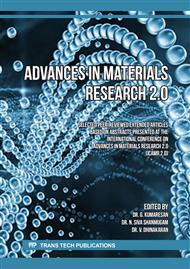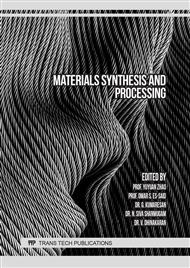[1]
Vigneshwaran, S., R. Sundarakannan, K. M. John, R. Deepak Joel Johnson, K. Arun Prasath, S. Ajith, V. Arumugaprabu, and M. Uthayakumar. Recent advancement in the natural fiber polymer composites: A comprehensive review., Journal of Cleaner Production (2020): 124109.
DOI: 10.1016/j.jclepro.2020.124109
Google Scholar
[2]
Selvam, R., L. Karunamoorthy, and N. Arunkumar. Investigation on performance of abrasive water jet in machining hybrid composites., Materials and Manufacturing Processes 32, no. 6 (2017): 700-706.
DOI: 10.1080/10426914.2016.1198039
Google Scholar
[3]
Jani, S. P., A. Senthil Kumar, M. Adam Khan, and A. Sujin Jose. Design and optimization of unit production cost for AWJ process on machining hybrid natural fibre composite material., International Journal of Lightweight Materials and Manufacture (2021).
DOI: 10.1016/j.ijlmm.2021.07.002
Google Scholar
[4]
Sujin Jose, A., Athijayamani, A., Jani, S. P., Stalany, M. V., & Khan, A. M. (2022). Investigations on Mechanical Properties of Bio-Waste Micro Particles Reinforced Phenol Formaldehyde Composites. Archives of Metallurgy and Materials, 67.
DOI: 10.1016/j.matpr.2020.07.360
Google Scholar
[5]
K. Sabeel Ahmed, S. Vijayarangan, Tensile, flexural and interlaminar shear properties of woven jute and jute glass fabric reinforced polyester composites, J. Mater. Process. Technol. 207 (2008) 330–335.
DOI: 10.1016/j.jmatprotec.2008.06.038
Google Scholar
[6]
Jani, S. P., Jose, A. S., Rajaganapathy, C., & Khan, M. A. (2022). A polymer resin matrix modified by coconut filler and its effect on structural behavior of glass fiber-reinforced polymer composites. Iranian Polymer Journal, 1-11.
DOI: 10.1007/s13726-022-01042-y
Google Scholar
[7]
Kumar, A. N., Jose, A. S., Tadepalli, N., Babu, V. V., Uppalapati, S., & Jani, S. P. (2022). A review on life cycle analysis and environmental sustainability assessment of bio-fuel. International Journal of Global Warming, 26(1), 74-103.
DOI: 10.1504/ijgw.2022.120069
Google Scholar
[8]
Cheung Hoi-yan, H.O. Mei-po, Lau Kin-tak, Cardon Francisco, Hui David, Natural fibre-reinforced composites for bioengineering and environmental engineering applications, Compos. B 40 (2009) 655-663.
DOI: 10.1016/j.compositesb.2009.04.014
Google Scholar
[9]
Haddad, M., Zitoune, R., Eyma, F., and Castanié, B., Influence of Machining Process and Machining Induced Surface Roughness on Mechanical Properties of Continuous Fiber Composites,, Exp. Mech., Vol. 55, No. 3, 2015, p.519–528.
DOI: 10.1007/s11340-014-9967-y
Google Scholar
[10]
Bandyopadhyay-Ghosh, S., Ghosh, S.B., Sain, M.,The use of biobased nanofibres in composites. In: Faruk, O., Sain, M. (Eds.), Biofiber Reinforcements in Composite Materials. Elsevier, Sawston, Cambridge, (2015) p.571–647. http://dx.doi.org/10.1533/ 9781782421276.5.571.
DOI: 10.1533/9781782421276.5.571
Google Scholar
[11]
Jose, A. S., Athijayamani, A., & Jani, S. P. (2021). A review on the mechanical properties of bio waste particulate reinforced polymer composites. Materials Today: Proceedings, 37, 1757-1760.
DOI: 10.1016/j.matpr.2020.07.360
Google Scholar
[12]
Saha, A., Kumar, S., & Kumar, A. (2021). Influence of pineapple leaf particulate on mechanical, thermal and biodegradation characteristics of pineapple leaf fiber reinforced polymer composite. Journal of Polymer Research, 28(2), 1-23.
DOI: 10.1007/s10965-021-02435-y
Google Scholar
[13]
Saravanakumaar, A., Senthilkumar, A., & Muthu Chozha Rajan, B. (2021). Effect of Fillers on Natural Fiber–Polymer Composite: An Overview of Physical and Mechanical Properties. Mechanical and Dynamic Properties of Biocomposites, 207-233.
DOI: 10.1002/9783527822331.ch11
Google Scholar
[14]
Jia, M., Qian, K., & Yu, K. (2022). Acoustic Emission Characteristics and Failure Patterns of Basalt Fiber and Basalt Textile Reinforced Concrete under Flexural Load. Journal of Natural Fibers, 1-19.
DOI: 10.1080/15440478.2022.2068728
Google Scholar
[15]
Barbière, R., Touchard, F., Chocinski-Arnault, L., & Mellier, D. (2020). Influence of moisture and drying on fatigue damage mechanisms in a woven hemp/epoxy composite: Acoustic emission and micro-CT analysis. International Journal of Fatigue, 136, 105593.
DOI: 10.1016/j.ijfatigue.2020.105593
Google Scholar



